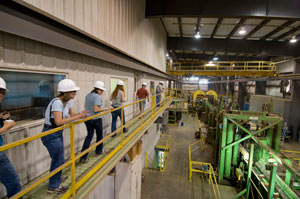By ERIC BARKER of the Tribune | Posted: Thursday, May 23, 2013 12:00 am
The Clearwater Basin Collaborative reached a milestone Wednesday with an agreement that outlines a strategy to bolster rural timber economies and county governments, while also restoring wildlife habitat and protecting pristine landscapes.
The group has been meeting for the past five years and wrestling with ways to put an end to bitter controversies surrounding the decades-long tug-of-war between conservation and logging in the Nez Perce-Clearwater National Forest.
“We believe this balanced package is the blueprint for breaking the gridlock that has paralyzed land management actions in the past,” said Alex Irby of Orofino, a co-chairman of the group.
The agreement and work plan proposes new wilderness and wild and scenic river designations, a significant increase in timber harvest from roaded areas of the forest, financial support for timber-dependent counties and economic development.
The collaborative, convened five years ago by U.S. Sen. Mike Crapo, R-Idaho, is made up of people representing diverse interests that have often battled over forest policy. It includes loggers, environmentalists, the Nez Perce Tribe, county commissioners, wildlife managers and off-roaders.
Much of it, such as the establishment of new wilderness areas, depends on Congressional legislation that Crapo has agreed to champion. But a large portion of it, such as increased timber harvest and forest restoration, can be accomplished administratively by the Forest Service.
The group has already seen some success in that arena. It was the driving force behind the Selway-Middle Fork Collaborative Forest Landscape Restoration Project, which is expected to bring in $40 million in federal funding over 10 years and yield as much as 60 million to 85 million board feet of timber.
Group members have also agreed to continue efforts with the Forest Service to comment on future logging and restoration plans and to define areas where they think logging is appropriate. While it may seem odd to see environmentalists supporting timber sales and county commissioners backing new wilderness, group members say one can’t happen without the other.
“You can’t pull any one of these out on their own,” said Brad Brooks of the Wilderness Society. “The key here is this only works if it’s all together.”
Don Ebert, chairman of the Clearwater County Commission, said the best thing he can do for his constituents is attempt to create jobs. The best way to do that is to work with other group members instead of fighting them.
“We have decided we need one another to get what we want and we decided since we are going to be in the same boat, we just as well all row in the same direction,” Ebert said.
Aaron Miles of the Nez Perce Tribe said the process is one tribal leaders were initially leery of, but have come to support.
“This is the way public land management should go, and not thinking about trying to undo a whole bunch of stuff just in order to get what one entity wants,” he said. “This is about all of us, not just one entity.”
The agreement includes the following elements:
- Support for short-term reauthorization of the Secure Rural Schools and Community Self Determination Act and to ensure a long-term, stable funding source for timber-dependent counties.
- Support for significantly increased timber harvest in roaded areas of the basin through ecologically based restoration.
- An agreement to define forest management principles on controversial subjects such as the use of temporary and permanent roads, old growth timber, logging prescriptions and restoration goals.
- Agreement to continue to work with the Forest Service over the life of the Selway-Middle Fork Collaborative Forest Landscape Restoration Project.
- Agreement to review and comment on Forest Service logging and restoration proposals.
- Support for Congressional reauthorization of stewardship contracting.
- Support for funding for equipment operators and primitive tool schools and a biofuels plant in the basin.
- The relocation of telecommunication equipment from Pilot Knob and protection of the area. Pilot Knob is an important cultural site of the Nez Perce Tribe.
- Designation of the Great Burn, Hoodoo, Sneakfoot Meadows, White Sands Creek, Mallard-Larkins and East Meadow Creek roadless areas as new wilderness or additions to existing wilderness.
- Designation of seven creeks, including Kelly Creek, Cayuse Creek and Meadow Creek, to the National Wild and Scenic River System.
- Congressional language requiring trail maintenance in newly designated wilderness areas and a system to pay outfitters who maintain trails to Forest Service standards.
- Support of wildlife habitat restoration with an emphasis on elk recovery.
- Support of establishment of the proposed North-South All-Terrain Vehicle Route between Avery and Elk City.
The agreement will soon be posted on the collaborative’s website at https://clearwaterbasincollaborative.org/.
Click here to view the Agreement and Work Plan.

